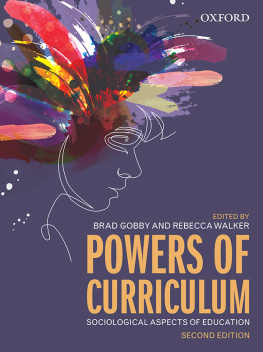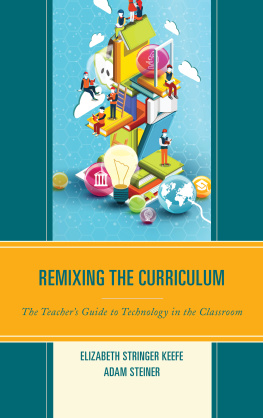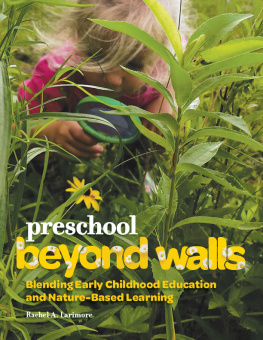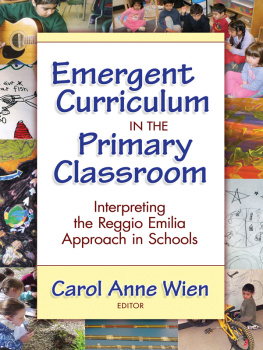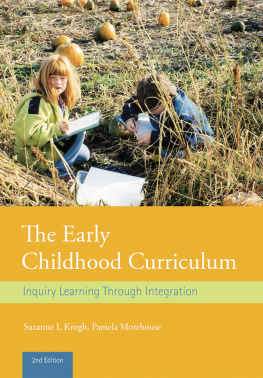in Early Childhood Settings
From Theory to Practice
Susan Stacey

For my children, Michael, Jennifer, and Matthew,
who taught me about childhood,
and my devoted parents, Dorothy and Lewis,
who find joy in being in the company of children
Contents
Published by Redleaf Press
10 Yorkton Court
St. Paul, MN 55117
www.redleafpress.org
2009 by Susan Stacey
All rights reserved. Unless otherwise noted on a specific page, no portion of this publication may be reproduced or transmitted in any form or by any means, electronic or mechanical, including photocopying, recording, or capturing on any information storage and retrieval system, without permission in writing from the publisher, except by a reviewer, who may quote brief passages in a critical article or review to be printed in a magazine or newspaper, or electronically transmitted on radio, television, or the Internet.
First edition 2009
Cover design by Soulo Communications
Cover photography by Bob Pearl
Interior design by by Soulo Communications
Typeset in Adobe Garamond Pro
Interior photographs and illustrations courtesy of the author
Wien, C. A., and S. Kirby-Smith. 1998. Untiming the Curriculum: A Case Study of Removing Clocks from the Program. Young Children 53 (5): 813. Reprinted with permission from the National Association for the Education of Young Children. Copyright 1998 NAEYC.
Wien, C. A., S. Stacey, B.-L. H. Keating, J. D. Rowlings, and H. Cameron. 2002. The Doll Project: Handmade Dolls as a Framework for Emergent Curriculum. Young Children 57 (1): 3338. Reprinted with permission from the National Association for the Education of Young Children. Copyright 2002 NAEYC.
Library of Congress Cataloging-in-Publication Data
Stacey, Susan.
Emergent curriculum in early childhood settings : from theory to practice / Susan Stacey.
p. cm.
Includes bibliographical references.
ISBN 978-1-60554-089-4 (e-book)
1. Early childhood educationCurricula. 2. Reflective teaching. I. Title.
LB1139.4.S73 2009
372.19dc22
2008008879
As a childor as a teacherhave you ever been bored in school?
For many of us, school was a same-old, same-old experiencea daily routine to be gotten through. True, as children we did learn the things that grown-ups thought were important for us to know. But the classroom wasnt often a place for learning about ourselves, our friends, or what really interested us in the world. That was more likely to happen at recess, in our neighborhoods, and at homeplaces where there was space and time to make choices, and friends to negotiate problems and enjoy solutions with.
As a teacher and caregiver of young children, are you ever bored? Life with the children can be pretty routine. Is your job just a schedule to be tolerated each dayfor you, and perhaps even for the children?
Many children now experience child care from infancy on. For some of them, child care may be simply an earlier beginning of schoolof doing what youre told, in a group. But thats not how young children and teachers learn best. In a well-ordered environment, young children are highly active, fascinated explorers of a world so new.
The children choose what to do, do it with great energy, and move on to the next challenge. The caregiver, watching the children, is an active learner too. Shes asking herself: Who are these children? What do they care about? What are their skills? What are they practicing? What should I offer them next?
Teaching, at its best, is a creative act. Susan Stacey has written Emergent Curriculum to remind us of that fact. She offers, through real-life stories from her own experiences and from those of her colleagues, a framework for practicing the art of emergent curriculum.
There are two basic approaches to curriculum planning and development: preplanned and emergent. The lure of preplanned curriculum is strong; its so easy to follow the directions somebody else has made up. And maybe youve been handed a fat book of activities and learning goals and told by your supervisor, This is our curriculum. Maybe youve been told your lesson plans need to be written down and turned in ahead of time, so the center can demonstrate its doing its job.
Young children know better. They dont learn just because we teach them. They learn when their interest is caught. They may not pay attention to your lesson if something else, in their heads and bodies or in the environment, is more interesting. Their bodies demand action; the world calls out for exploration. Children are wired to construct their knowledge of the world through constant practice.
If we want a world peopled by intelligent children and adults, we need to respond to childrens inherent motivation to learn, which is at its height in early childhood. Teachers and caregivers of young children are at their best when they follow the children as models for their own adult curiosity, learning with them and about them. We watch the children, we think, we respond, and thats how curriculum emerges.
You cant write an emergent curriculum and package it for sale. Emergent curriculum is invented by its participants, which is more work for teachers and caregivers, because it requires continual alertness. Its also more fun and more educational, because its full of surprises and new challenges. It cant really be written until after its happened; emergent curriculum is ex post facto curriculum, which can be a problem for you if youre required to produce lesson plans in advance. In this book Susan Stacey deals helpfully with this dilemma, especially in a detailed look at the process of documentation, in which teachers take notes, pictures, and examples of childrens work to create visual representations of childrens emergent learning.
Many of the books college students and on-the-job teachers are asked to read are full of principles and best practices and theories and lists and lesson plans and study questions. They demand: Are you learning what were teaching you? Memorize it; it will be on the test. If youre a good teacher, you will do it in your classroom. Strangely enoughor perhaps not so strangelymany early childhood practitioners dont do it in their classrooms (even though they passed the test).
As a college instructor in early childhood education, I frequently find myself in conversation with colleagues at other colleges, and their repeated lament is How can we get them to do what weve taught them? My response is that mostly, we cant. Teachers and other grown-ups, Ive noticed, dont change their behaviors just because theyve learned the principles of why they should adopt developmentally appropriate practice or any other theoretical model. We go through the effort of changing our behaviors if were anxious about getting in trouble, if were bored and looking for something new to try, or if were inspired by a life-changing experiencewhich could take the form of stories about someone elses work with children.
Emergent Curriculum is a collection of stories about someone elses work with young children. Enjoy themand as you do, ponder some of the explanations of why the teachers and caregivers worked with the children in these ways. If you were to try something similar, what would happen? Would your children run wild? Would you get in trouble for changing the lesson plan? Would you have new stories about the children to share with their parents? Would you learn new things about the world, about children, and about yourself?




